英语2011届高考复习课件:时态和语态
文档属性
| 名称 | 英语2011届高考复习课件:时态和语态 | 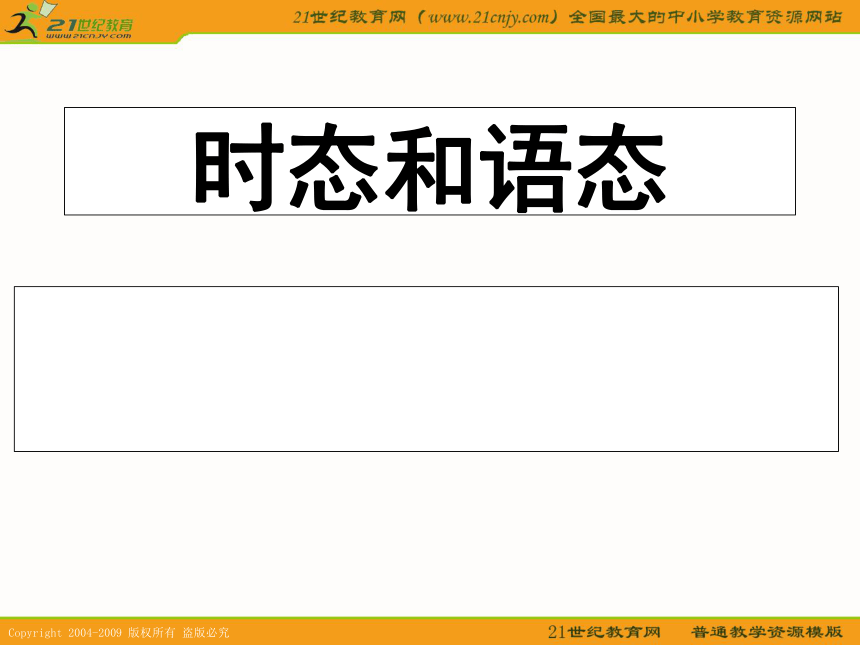 | |
| 格式 | rar | ||
| 文件大小 | 118.6KB | ||
| 资源类型 | 教案 | ||
| 版本资源 | 牛津译林版 | ||
| 科目 | 英语 | ||
| 更新时间 | 2010-10-17 11:44:00 | ||
图片预览

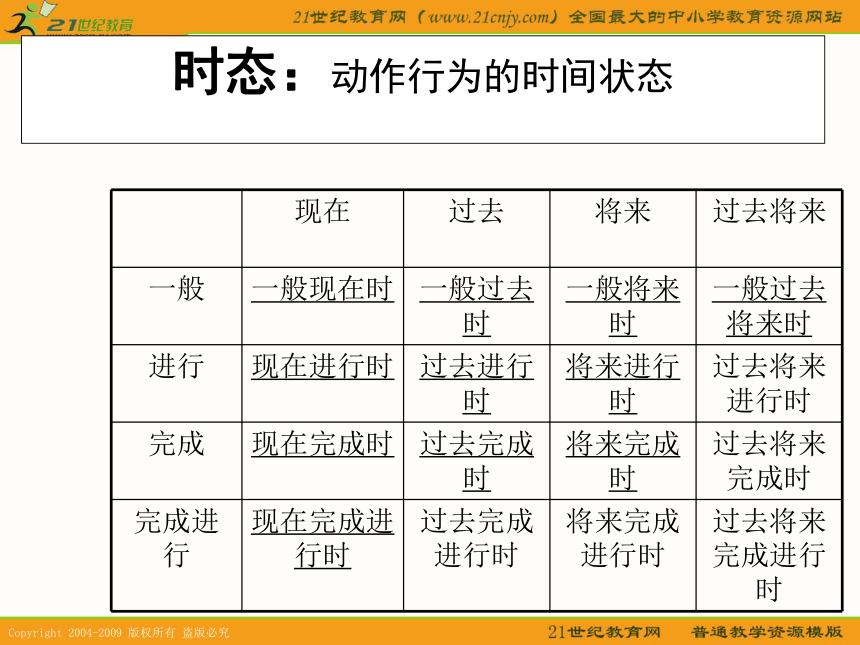
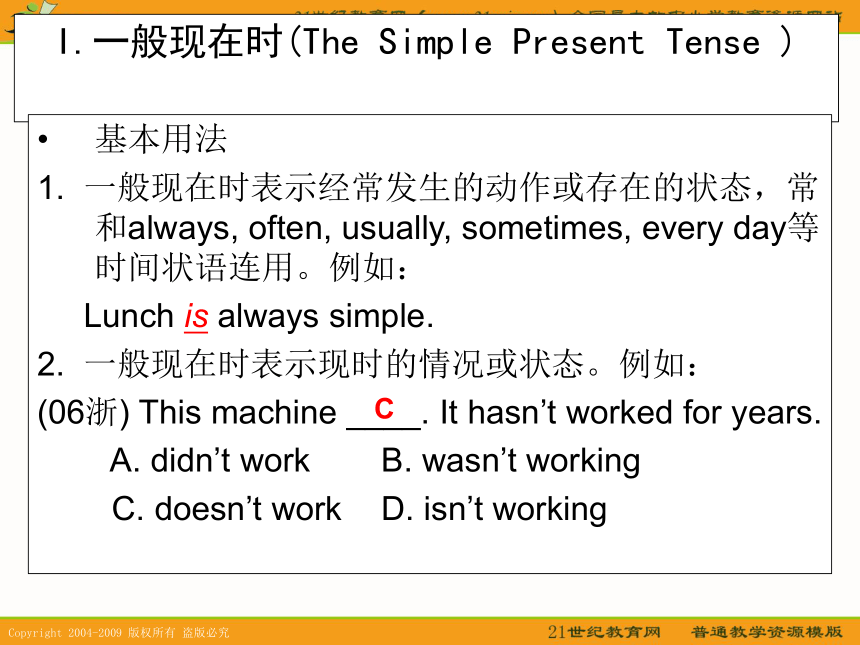

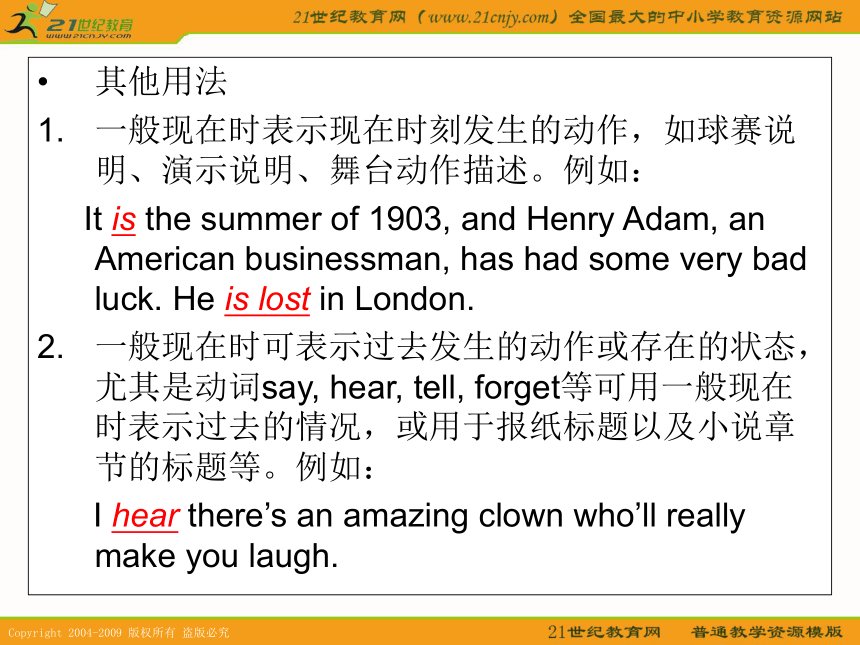

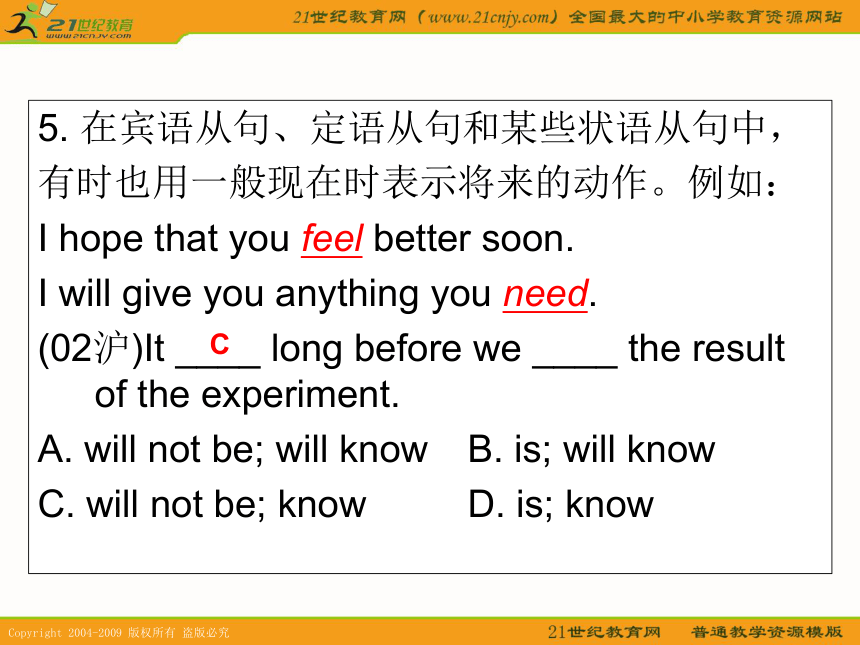

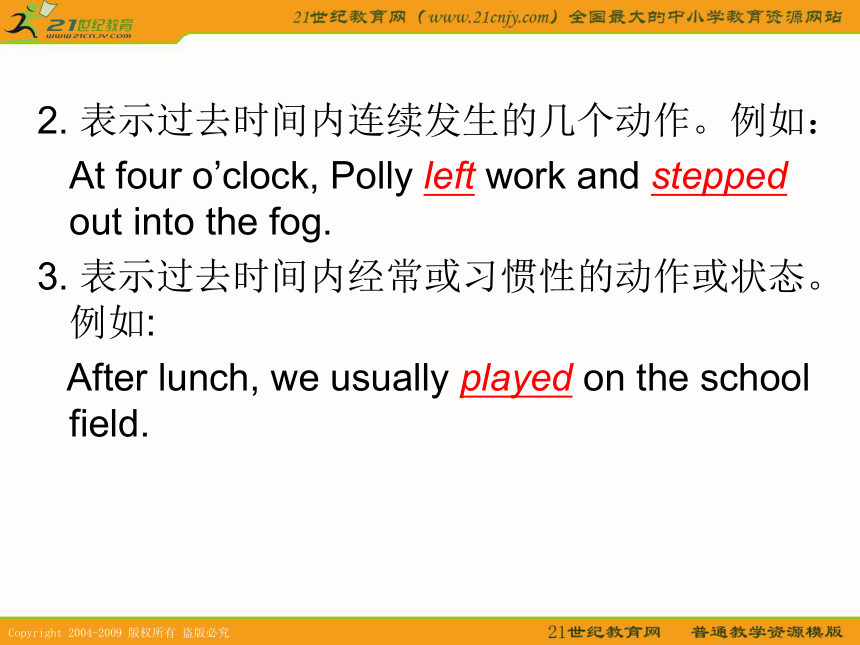
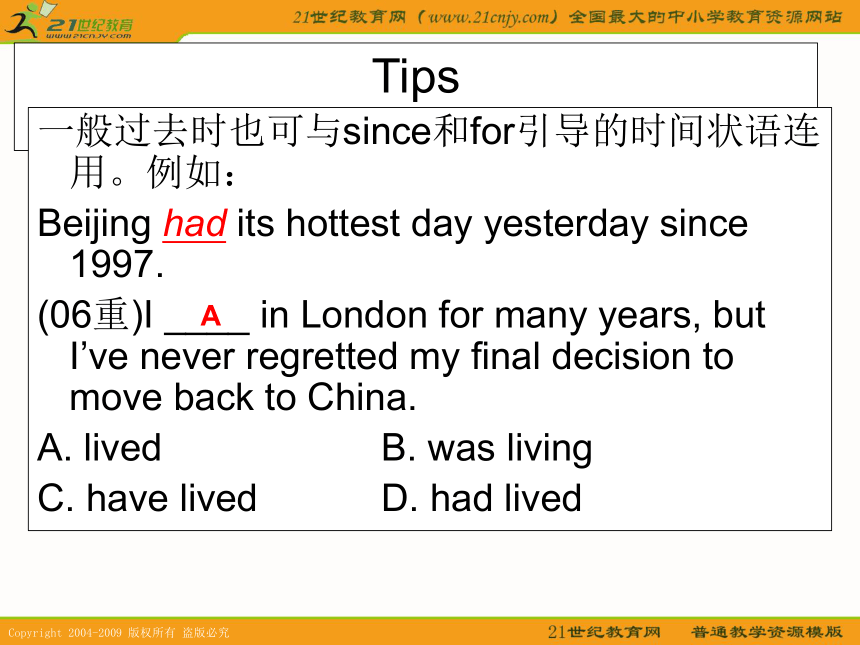
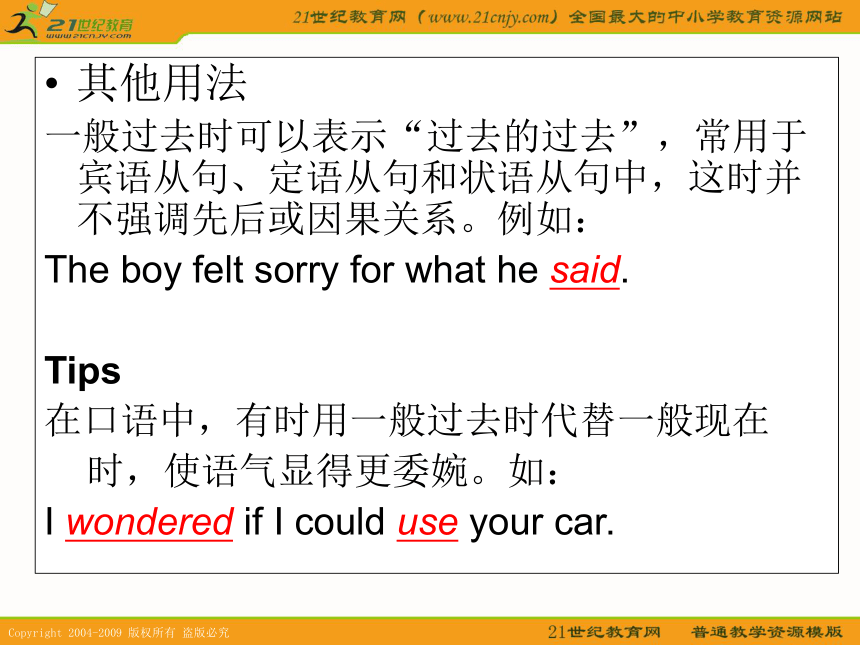

文档简介
课件45张PPT。时态和语态时态:动作行为的时间状态I.一般现在时(The Simple Present Tense )基本用法
1. 一般现在时表示经常发生的动作或存在的状态,常和always, often, usually, sometimes, every day等时间状语连用。例如:
Lunch is always simple.
2. 一般现在时表示现时的情况或状态。例如:
(06浙) This machine ____. It hasn’t worked for years.
A. didn’t work B. wasn’t working
C. doesn’t work D. isn’t workingC3. 一般现在时表示客观事实、客观规律或客观
真理。例如:
Time and tide wait for no man.
The sun rises in the east.
The Dragon Boat Festival falls on the fifth day of the fifth month of the lunar year.其他用法
一般现在时表示现在时刻发生的动作,如球赛说明、演示说明、舞台动作描述。例如:
It is the summer of 1903, and Henry Adam, an American businessman, has had some very bad luck. He is lost in London.
一般现在时可表示过去发生的动作或存在的状态,尤其是动词say, hear, tell, forget等可用一般现在时表示过去的情况,或用于报纸标题以及小说章节的标题等。例如:
I hear there’s an amazing clown who’ll really make you laugh.3. 在口语中,一般现在时常可表示计划或安排好的将来的动作,多用于go, come, arrive, leave, start等动词, 通常与表示将来的时间状语连用。例如:
We leave London on 15th July, and we’ll be flying to
Morocco, in Northern Africa.
4. 在时间或条件状语从句中,须用一般现在时表示将来的动作,而不用一般将来时。例如:
We will not give up until we find convincing evidence.
I will definitely study medicine after I finish school.5. 在宾语从句、定语从句和某些状语从句中,
有时也用一般现在时表示将来的动作。例如:
I hope that you feel better soon.
I will give you anything you need.
(02沪)It ____ long before we ____ the result of the experiment.
A. will not be; will know B. is; will know
C. will not be; know D. is; knowCII.一般过去时(The Simple Past Tense)基本用法
表示过去某时发生的动作或存在的状态,常和a moment ago, half an hour ago, just now, yesterday, last week, in 2005, in those days, at that time等表示过去的时间状语连用。例:
We soon became good friends.
Two years ago, she bought an expensive bike.
2. 表示过去时间内连续发生的几个动作。例如:
At four o’clock, Polly left work and stepped out into the fog.
3. 表示过去时间内经常或习惯性的动作或状态。例如:
After lunch, we usually played on the school field.Tips 一般过去时也可与since和for引导的时间状语连用。例如:
Beijing had its hottest day yesterday since 1997.
(06重)I ____ in London for many years, but I’ve never regretted my final decision to move back to China.
A. lived B. was living
C. have lived D. had lived
A其他用法
一般过去时可以表示“过去的过去”,常用于宾语从句、定语从句和状语从句中,这时并不强调先后或因果关系。例如:
The boy felt sorry for what he said.
Tips
在口语中,有时用一般过去时代替一般现在
时,使语气显得更委婉。如:
I wondered if I could use your car.
III.一般将来时(The Simple Future Tense )基本用法
表示将要发生的事。Shall一般用于第一人称,will用
于所有人称。例如:
Next month we will have our school open day.
Later I shall tell you about some of the work I have
done.
(05京)As soon as he comes back, I’ll tell him when ____ and see him.
A. you will come B. will you come
C. you come D. do you comeA其他用法
1.“be going to+动词原形”表示打算做某事或即将发生某事。例如:
The speech is going to be at 3 p.m. on 9th
October.
2.begin, leave, arrive等动词的一般现在时可表示按计划或安排将要发生的事。例如:
When does the plane arrive?
3. leave, go, come, stay, do, take, have等动词
的现在进行时可表示计划或准备要做某事。
例如:
We’re leaving school in one year’s time.
4. “be to+动词原形”表示即将发生某事,或安
排做某事,或要求做某事。例如:
What am I to do?
5. “be about to+动词原形”表示即将发生某事。
Now ladies and gentlemen, you’re about to
hear the most incredible tale.IV.过去将来时(The Past Future Tense)基本用法
表示从过去某一时间看,即将发生的动作或存
在的状态,多用would。例如:
She said she would be there at seven o’clock,
and he thought she would keep her word.
其他用法
1. come, go, leave等动词用过去进行时表示过去某时打算做某事。例如:
My cousin told me he was leaving for New Zealand the next morning.
2. “was/were going to+动词原形”和“was/were about to +动词原形”也可表示过去某时预计即将要做某事。例如:
She was about to go when the phone rang.
When I arrived at the airport, the plane was just going to take off.
V.现在进行时(The Present Continuous Tense)基本用法
1. 表示说话时正在进行的动作或发生的事情。例如:
Now she is planning our schedule for the trip.
2. 表示现阶段正在进行的动作,但说话时不一定正在进行。例如:
Wushu, a Chinese martial art, is still trying to get into the Olympics.其他用法
1. go, come, stay, leave, do take, have等动词的现在进行时可用来表示按计划或安排将要做某事,特别是在口语中。例如:
Then we’re going to the Himalayas.
(06福)Ladies and gentlemen, please fasten your seat belts. The plane ____.
A. take off B. is taking off
C. has taken off D. took off
2. 现在进行时常与always, forever, constantly等副词连用,带有厌恶,赞扬等感彩。You’re always telling people about your exciting sculpture classes.
BVI.过去进行时(The Past Continuous Tense)基本用法
表示过去某时刻或某阶段正在进行的动作,常与then,
at that time, yesterday, at nine, from 7 to 9 yesterday
morning, last night等时间状语连用。但不少情况下,
没有表示时间的状语,而是通过上下文来表示。
Susan decided not to work on the program at home because she didn’t want her parents to know what she ___. (05辽)
A. has done B. had done
C. was doing D. is doing
CTips在口语中,有时用过去进行时表示现在的想法,语气显得委婉。例:
I was wondering if you could do me a favor.
I was hoping you could give us an early reply.
过去进行时与一般过去时的区别 1.时间状语不同
2. 强调动作的角度不同
一般过去时强调动作已完成,而过去进行时强调动作正在进行。试比较:I did the maths test.
I was doing my homework at nine last night.Tipsleave, arrive, start, die等动词的过去进行时表示“快要完成或即将完成”的动作,而一般过去时表示“已经完成”的动作。
He was dying. He died.
3.动词的类型不同
A 有些动词可用一般过去时,而不能用过去进行时。例如:
表示感官:hear, know, see, smell, taste等;
表示状态、感情:be, dislike, have, hate, love,
want, wish;
表示心理活动:forget, realize, recognize,
remember, understand等;
表示所属关系:own, belong等。
B 一般过去时的谓语动词既可是延续性的,也可是终止性的,而过去进行时的谓语动词只能是延续性的。例如:
His cousin joined the army in 1999. (终止性动词)
My mother was cooking when I got home. (延续性)
4.感彩不同
一般过去时是对过去发生的事进行客观描述;而过去进行时与forever, always, frequently等连用时,带有埋怨、厌烦、赞扬等感彩。
Your son came late to school this morning.
Your son was always coming late to school.
VII.将来进行时(The Future Continuous Tense)基本用法
1.表示将来某一时间正在进行的动作,一般与表示将来的时间状语连用,如soon, tomorrow, this evening, on Sunday, by this time tomorrow, in two days, tomorrow evening等。例如:
I’m not really sure what I will be doing in ten years from now.
(03京)At this time tomorrow ____over the Atlantic.
we’re going to fly B. we’ll be flying
C. we’ll fly D. we’re to fly
B2. 将来进行时还可表示安排要做的事或预计会发生的
事。例如:
We’ll be taking an examination next week.
This time next week, I’ll be arriving in New York.
Tips
在口语中,将来进行时用得较多,而且可与现在进行时互换,意义无区别。例如:
I’ll be meeting Mary tomorrow=I’m meeting Mary tomorrow.
b. 有时将来进行时可与一般将来时互换,但意义有细微的差别。试比较:
Won’t you come to our party?(表示邀请)
Won’t you be coming to our party?(单纯谈事实)
VIII.现在完成时(The Present Perfect Tense)基本用法
表示动作发生在过去,但其结果影响到现在,可以和一些表示不确定的时间状语连用,如just, already, yet, ever, recently, so far等。例如:
We’ve done a lot of work on it, but we haven’t finished yet.
2. 表示动作或状态从过去某一时刻开始一直持续到现在,还可能持续下去,常与for和since等引起的表示一段时间的状语连用。
I’ve lost 7 kg in the last two months.3. 表示说话前发生过一次或多次的动作,现在成为一
种经历,常带有twice, ever, never, three times, before等时间状语。例如:
I’ve never seen her as angry as that, so I kept quiet.
Tips
a. come, arrive, buy, hear等终止性动词的现在完成时一般不能与表示一段时间的状语连用。
He has joined the army for three years.
He has been a soldier for three years.
He has been in the army for three years.
b. hear等词的否定式可以与for等引起的表示一段时间状语连用。例如:
I haven’t heard from you for weeks.现在完成时与一般过去时的区别
都表示过去发生的动作。差别在于:现在完成时强调的是这一动作与现在的关系,即对现在的影响;而一般过去时只表示动作在过去某时发生,不表示和现在有关系。因此,句中有过去时间状语时,通常用一般过去时。试比较:
I have lost my new bike. (未找到)
I lost my new bike yesterday. (不清楚结果)
He worked there for three years. (已不在)
He has worked there for three years. (仍在)IX.过去完成时(The Past Perfect Tense)基本用法
表示一个动作或状态在过去某一时间或动作之前已经完成或结束,即发生在“过去的过去”,常与by, before, when, until等引导的时间状语连用。例如:
(06粤)The young girl sitting next to me on the plane was very nervous. She ____ before.
A. hasn’t flown B. didn’t fly
C. hadn’t flown D. wasn’t flying
2. 还可表示过去某一时间的动作或状态持续到过去另一时间,还可能持续下去,常与for, since 等词连用。例如:
It was the fastest I’d seen him move since 1964.CTips先发生的动作用过去完成时,后发生的动作用一般过去时,过去某时刻正在进行的动作用过去进行时。时态综合运用的典型例题:
(91)The students ____ busily when Miss Brown went
to get a book she ____ in the office.
A. had written; left B. were writing; has left
C. had written; had left D. were writing; had left
Tom flew home, but his father had already died.D其他用法
hope, expect, suppose, think, want, wish等动词的过去完成时表示过去未实现的愿望、计划或打算。例如:
They had hoped to be able to arrive before ten.
Like every school boy I had thought that going
into space as an astronaut must be the best job
in the world.
过去完成时还用于状语从句的两个常用句型的主句中:hardly…when(刚……就)和
no sooner…than(刚……就)。例如:
Hardly had it grown dark when he realized it was
too late to return home.
Tips在before, after等引导的时间状语从句中,由于这些连词本身已经表示出时间先后,所以主句或从句的谓语动词可以用一般过去时来代替过去完成时。例:
She and her family hid away for nearly twenty-five months before they were discovered.
在when引导的时间状语从句中,谓语动词的动作发生后,主句谓语动词的动作紧挨着发生,这时两者均用一般过去时。例如:
When he heard these words, Jim panicked and ran to the raft.
如果从句中有明确的表示过去时间的状语,则常用一般过去时。例如:
He said he was born in 1991.
X.现在完成进行时 (The Present Perfect Continuous Tense)基本用法
表示动作从过去某一时间开始一直持续到现
在。这个动作可能刚终止,也可能还在进行。
如:I haven’t been sleeping well since I returned
home.
(04京)Now that she is out of a job, Lucy ____
going back to school, but she hasn’t
decided yet.
A. had considered B. has been considering
C. considered D. is going to consider
B现在完成进行时与现在完成时的区别
现在完成进行时的动作不一定已经完成,很可能持续下去,而现在完成时一般表示动作已经完成。例如:
You’ve been designing solar racing cars for a long time.
I’ve designed five or six different cars so far.
2. 现在完成进行时往往表示动作在重复,而现在完成时一般不表示动作的重复。例如:
I’ve been taking part in races for about four years.
How many races have you taken part in?
3.现在完成进行时与所有进行时态一样带有感彩,可使表达显得生动,而现在完成时往往只标明一个事实,一种影响或结果,不带感彩。例如:
What have you been doing? You look fed up.
(你一直在干什么呀?你看上去很不爽。)Tips –过去完成进行时表示动作从过去某时开始,一直延续到过去另一时间。例如:
Finally, after he had been waiting for about an hour, he was called in.
过去完成进行时与现在完成进行时的用法相似,只不过把时间从现在移到了过去。试比较:
How long have you been waiting?
She asked me how long I had been waiting.
(04重)The crazy fans ____ patiently for two hours, and they would wait until the movie star arrived.
were waiting B. had been waiting
C. had waited D. would wait
BXI.将来完成时(The Future Perfect Tense)表示在将来某一时间之前完成的动作,常与表示将来的时间状语连用。例如:
By this summer, I’ll have lived in beijing for nine years.
(05津)By the time Jane gets home, her aunt
____ for London to attend a meeting.
A. will have B. leaves
C. will have left D. leftC语 态语态(Voices)用来表示主语与谓语之间的关系,它是动词的一种形式。英语中有两种语态:主动语态(Active Voice)和被动语态(Passive Voice)。
主动语态表示主语是动作的执行者,被动语态表示主语是动作的承受者。I.主动和被动的转换II. 被动语态的使用场合不知道动作的执行者,没有必要知道动作的执行者或强调动作的承受者时,常使用被动语态。例如:
In the future all shopping will be done online.
Unlike today’s Olympic Games, the ancient
games were always held at the same place.
The trip is organized by a well-known tourist
company with a good reputation.III.应注意的问题不能用于被动语态的动词
一般说来,只有及物动词才有被动语态,但少数及物动词如have, leave, become, cost, enter, reach, suit, benefit, lack等以及短语动词take place, lose heart, break out, belong to, consist of等,一般不能用于被动语态。例如:
When we reached a valley, it became much warmer.
This book consists of 25 chapters.主动形式表示被动意义
某些系动词taste, feel, look, smell, sound, prove等与形容词连用时。例如:
The flowers smell sweet.
The water ____ cool when I jumped into the pool for morning exercise.
A. was felt B. is felt C. felt D. feels
某些不及物动词sell, wash, read, write, wear, play等与副词well, easily等连用时。
His novel sells well.
The cloth washes easily.
3. 某些不及物动词open, shut, start, act, keep, move等与can’t, won’t, doesn’t等连用时。
The library doesn’t open on Sunday.
The door won’t shut.C被动语态与系表结构的区别
从形式上看,被动语态和“be+过去分词”的系表结构完全一样,但它们的区别在于:被动语态表示动作,其后常跟有by短语,表示动作的执行者;系表结构表示状态,其后一般不跟by短语。试比较:
The teacher was pleased with her answer.
The teacher was pleased by her answer.
The door is closed.
The door was closed by Alice.
My car is made of some special material which is
light and can be folded easily.
My car was made in Germany.谢谢!再见!
1. 一般现在时表示经常发生的动作或存在的状态,常和always, often, usually, sometimes, every day等时间状语连用。例如:
Lunch is always simple.
2. 一般现在时表示现时的情况或状态。例如:
(06浙) This machine ____. It hasn’t worked for years.
A. didn’t work B. wasn’t working
C. doesn’t work D. isn’t workingC3. 一般现在时表示客观事实、客观规律或客观
真理。例如:
Time and tide wait for no man.
The sun rises in the east.
The Dragon Boat Festival falls on the fifth day of the fifth month of the lunar year.其他用法
一般现在时表示现在时刻发生的动作,如球赛说明、演示说明、舞台动作描述。例如:
It is the summer of 1903, and Henry Adam, an American businessman, has had some very bad luck. He is lost in London.
一般现在时可表示过去发生的动作或存在的状态,尤其是动词say, hear, tell, forget等可用一般现在时表示过去的情况,或用于报纸标题以及小说章节的标题等。例如:
I hear there’s an amazing clown who’ll really make you laugh.3. 在口语中,一般现在时常可表示计划或安排好的将来的动作,多用于go, come, arrive, leave, start等动词, 通常与表示将来的时间状语连用。例如:
We leave London on 15th July, and we’ll be flying to
Morocco, in Northern Africa.
4. 在时间或条件状语从句中,须用一般现在时表示将来的动作,而不用一般将来时。例如:
We will not give up until we find convincing evidence.
I will definitely study medicine after I finish school.5. 在宾语从句、定语从句和某些状语从句中,
有时也用一般现在时表示将来的动作。例如:
I hope that you feel better soon.
I will give you anything you need.
(02沪)It ____ long before we ____ the result of the experiment.
A. will not be; will know B. is; will know
C. will not be; know D. is; knowCII.一般过去时(The Simple Past Tense)基本用法
表示过去某时发生的动作或存在的状态,常和a moment ago, half an hour ago, just now, yesterday, last week, in 2005, in those days, at that time等表示过去的时间状语连用。例:
We soon became good friends.
Two years ago, she bought an expensive bike.
2. 表示过去时间内连续发生的几个动作。例如:
At four o’clock, Polly left work and stepped out into the fog.
3. 表示过去时间内经常或习惯性的动作或状态。例如:
After lunch, we usually played on the school field.Tips 一般过去时也可与since和for引导的时间状语连用。例如:
Beijing had its hottest day yesterday since 1997.
(06重)I ____ in London for many years, but I’ve never regretted my final decision to move back to China.
A. lived B. was living
C. have lived D. had lived
A其他用法
一般过去时可以表示“过去的过去”,常用于宾语从句、定语从句和状语从句中,这时并不强调先后或因果关系。例如:
The boy felt sorry for what he said.
Tips
在口语中,有时用一般过去时代替一般现在
时,使语气显得更委婉。如:
I wondered if I could use your car.
III.一般将来时(The Simple Future Tense )基本用法
表示将要发生的事。Shall一般用于第一人称,will用
于所有人称。例如:
Next month we will have our school open day.
Later I shall tell you about some of the work I have
done.
(05京)As soon as he comes back, I’ll tell him when ____ and see him.
A. you will come B. will you come
C. you come D. do you comeA其他用法
1.“be going to+动词原形”表示打算做某事或即将发生某事。例如:
The speech is going to be at 3 p.m. on 9th
October.
2.begin, leave, arrive等动词的一般现在时可表示按计划或安排将要发生的事。例如:
When does the plane arrive?
3. leave, go, come, stay, do, take, have等动词
的现在进行时可表示计划或准备要做某事。
例如:
We’re leaving school in one year’s time.
4. “be to+动词原形”表示即将发生某事,或安
排做某事,或要求做某事。例如:
What am I to do?
5. “be about to+动词原形”表示即将发生某事。
Now ladies and gentlemen, you’re about to
hear the most incredible tale.IV.过去将来时(The Past Future Tense)基本用法
表示从过去某一时间看,即将发生的动作或存
在的状态,多用would。例如:
She said she would be there at seven o’clock,
and he thought she would keep her word.
其他用法
1. come, go, leave等动词用过去进行时表示过去某时打算做某事。例如:
My cousin told me he was leaving for New Zealand the next morning.
2. “was/were going to+动词原形”和“was/were about to +动词原形”也可表示过去某时预计即将要做某事。例如:
She was about to go when the phone rang.
When I arrived at the airport, the plane was just going to take off.
V.现在进行时(The Present Continuous Tense)基本用法
1. 表示说话时正在进行的动作或发生的事情。例如:
Now she is planning our schedule for the trip.
2. 表示现阶段正在进行的动作,但说话时不一定正在进行。例如:
Wushu, a Chinese martial art, is still trying to get into the Olympics.其他用法
1. go, come, stay, leave, do take, have等动词的现在进行时可用来表示按计划或安排将要做某事,特别是在口语中。例如:
Then we’re going to the Himalayas.
(06福)Ladies and gentlemen, please fasten your seat belts. The plane ____.
A. take off B. is taking off
C. has taken off D. took off
2. 现在进行时常与always, forever, constantly等副词连用,带有厌恶,赞扬等感彩。You’re always telling people about your exciting sculpture classes.
BVI.过去进行时(The Past Continuous Tense)基本用法
表示过去某时刻或某阶段正在进行的动作,常与then,
at that time, yesterday, at nine, from 7 to 9 yesterday
morning, last night等时间状语连用。但不少情况下,
没有表示时间的状语,而是通过上下文来表示。
Susan decided not to work on the program at home because she didn’t want her parents to know what she ___. (05辽)
A. has done B. had done
C. was doing D. is doing
CTips在口语中,有时用过去进行时表示现在的想法,语气显得委婉。例:
I was wondering if you could do me a favor.
I was hoping you could give us an early reply.
过去进行时与一般过去时的区别 1.时间状语不同
2. 强调动作的角度不同
一般过去时强调动作已完成,而过去进行时强调动作正在进行。试比较:I did the maths test.
I was doing my homework at nine last night.Tipsleave, arrive, start, die等动词的过去进行时表示“快要完成或即将完成”的动作,而一般过去时表示“已经完成”的动作。
He was dying. He died.
3.动词的类型不同
A 有些动词可用一般过去时,而不能用过去进行时。例如:
表示感官:hear, know, see, smell, taste等;
表示状态、感情:be, dislike, have, hate, love,
want, wish;
表示心理活动:forget, realize, recognize,
remember, understand等;
表示所属关系:own, belong等。
B 一般过去时的谓语动词既可是延续性的,也可是终止性的,而过去进行时的谓语动词只能是延续性的。例如:
His cousin joined the army in 1999. (终止性动词)
My mother was cooking when I got home. (延续性)
4.感彩不同
一般过去时是对过去发生的事进行客观描述;而过去进行时与forever, always, frequently等连用时,带有埋怨、厌烦、赞扬等感彩。
Your son came late to school this morning.
Your son was always coming late to school.
VII.将来进行时(The Future Continuous Tense)基本用法
1.表示将来某一时间正在进行的动作,一般与表示将来的时间状语连用,如soon, tomorrow, this evening, on Sunday, by this time tomorrow, in two days, tomorrow evening等。例如:
I’m not really sure what I will be doing in ten years from now.
(03京)At this time tomorrow ____over the Atlantic.
we’re going to fly B. we’ll be flying
C. we’ll fly D. we’re to fly
B2. 将来进行时还可表示安排要做的事或预计会发生的
事。例如:
We’ll be taking an examination next week.
This time next week, I’ll be arriving in New York.
Tips
在口语中,将来进行时用得较多,而且可与现在进行时互换,意义无区别。例如:
I’ll be meeting Mary tomorrow=I’m meeting Mary tomorrow.
b. 有时将来进行时可与一般将来时互换,但意义有细微的差别。试比较:
Won’t you come to our party?(表示邀请)
Won’t you be coming to our party?(单纯谈事实)
VIII.现在完成时(The Present Perfect Tense)基本用法
表示动作发生在过去,但其结果影响到现在,可以和一些表示不确定的时间状语连用,如just, already, yet, ever, recently, so far等。例如:
We’ve done a lot of work on it, but we haven’t finished yet.
2. 表示动作或状态从过去某一时刻开始一直持续到现在,还可能持续下去,常与for和since等引起的表示一段时间的状语连用。
I’ve lost 7 kg in the last two months.3. 表示说话前发生过一次或多次的动作,现在成为一
种经历,常带有twice, ever, never, three times, before等时间状语。例如:
I’ve never seen her as angry as that, so I kept quiet.
Tips
a. come, arrive, buy, hear等终止性动词的现在完成时一般不能与表示一段时间的状语连用。
He has joined the army for three years.
He has been a soldier for three years.
He has been in the army for three years.
b. hear等词的否定式可以与for等引起的表示一段时间状语连用。例如:
I haven’t heard from you for weeks.现在完成时与一般过去时的区别
都表示过去发生的动作。差别在于:现在完成时强调的是这一动作与现在的关系,即对现在的影响;而一般过去时只表示动作在过去某时发生,不表示和现在有关系。因此,句中有过去时间状语时,通常用一般过去时。试比较:
I have lost my new bike. (未找到)
I lost my new bike yesterday. (不清楚结果)
He worked there for three years. (已不在)
He has worked there for three years. (仍在)IX.过去完成时(The Past Perfect Tense)基本用法
表示一个动作或状态在过去某一时间或动作之前已经完成或结束,即发生在“过去的过去”,常与by, before, when, until等引导的时间状语连用。例如:
(06粤)The young girl sitting next to me on the plane was very nervous. She ____ before.
A. hasn’t flown B. didn’t fly
C. hadn’t flown D. wasn’t flying
2. 还可表示过去某一时间的动作或状态持续到过去另一时间,还可能持续下去,常与for, since 等词连用。例如:
It was the fastest I’d seen him move since 1964.CTips先发生的动作用过去完成时,后发生的动作用一般过去时,过去某时刻正在进行的动作用过去进行时。时态综合运用的典型例题:
(91)The students ____ busily when Miss Brown went
to get a book she ____ in the office.
A. had written; left B. were writing; has left
C. had written; had left D. were writing; had left
Tom flew home, but his father had already died.D其他用法
hope, expect, suppose, think, want, wish等动词的过去完成时表示过去未实现的愿望、计划或打算。例如:
They had hoped to be able to arrive before ten.
Like every school boy I had thought that going
into space as an astronaut must be the best job
in the world.
过去完成时还用于状语从句的两个常用句型的主句中:hardly…when(刚……就)和
no sooner…than(刚……就)。例如:
Hardly had it grown dark when he realized it was
too late to return home.
Tips在before, after等引导的时间状语从句中,由于这些连词本身已经表示出时间先后,所以主句或从句的谓语动词可以用一般过去时来代替过去完成时。例:
She and her family hid away for nearly twenty-five months before they were discovered.
在when引导的时间状语从句中,谓语动词的动作发生后,主句谓语动词的动作紧挨着发生,这时两者均用一般过去时。例如:
When he heard these words, Jim panicked and ran to the raft.
如果从句中有明确的表示过去时间的状语,则常用一般过去时。例如:
He said he was born in 1991.
X.现在完成进行时 (The Present Perfect Continuous Tense)基本用法
表示动作从过去某一时间开始一直持续到现
在。这个动作可能刚终止,也可能还在进行。
如:I haven’t been sleeping well since I returned
home.
(04京)Now that she is out of a job, Lucy ____
going back to school, but she hasn’t
decided yet.
A. had considered B. has been considering
C. considered D. is going to consider
B现在完成进行时与现在完成时的区别
现在完成进行时的动作不一定已经完成,很可能持续下去,而现在完成时一般表示动作已经完成。例如:
You’ve been designing solar racing cars for a long time.
I’ve designed five or six different cars so far.
2. 现在完成进行时往往表示动作在重复,而现在完成时一般不表示动作的重复。例如:
I’ve been taking part in races for about four years.
How many races have you taken part in?
3.现在完成进行时与所有进行时态一样带有感彩,可使表达显得生动,而现在完成时往往只标明一个事实,一种影响或结果,不带感彩。例如:
What have you been doing? You look fed up.
(你一直在干什么呀?你看上去很不爽。)Tips –过去完成进行时表示动作从过去某时开始,一直延续到过去另一时间。例如:
Finally, after he had been waiting for about an hour, he was called in.
过去完成进行时与现在完成进行时的用法相似,只不过把时间从现在移到了过去。试比较:
How long have you been waiting?
She asked me how long I had been waiting.
(04重)The crazy fans ____ patiently for two hours, and they would wait until the movie star arrived.
were waiting B. had been waiting
C. had waited D. would wait
BXI.将来完成时(The Future Perfect Tense)表示在将来某一时间之前完成的动作,常与表示将来的时间状语连用。例如:
By this summer, I’ll have lived in beijing for nine years.
(05津)By the time Jane gets home, her aunt
____ for London to attend a meeting.
A. will have B. leaves
C. will have left D. leftC语 态语态(Voices)用来表示主语与谓语之间的关系,它是动词的一种形式。英语中有两种语态:主动语态(Active Voice)和被动语态(Passive Voice)。
主动语态表示主语是动作的执行者,被动语态表示主语是动作的承受者。I.主动和被动的转换II. 被动语态的使用场合不知道动作的执行者,没有必要知道动作的执行者或强调动作的承受者时,常使用被动语态。例如:
In the future all shopping will be done online.
Unlike today’s Olympic Games, the ancient
games were always held at the same place.
The trip is organized by a well-known tourist
company with a good reputation.III.应注意的问题不能用于被动语态的动词
一般说来,只有及物动词才有被动语态,但少数及物动词如have, leave, become, cost, enter, reach, suit, benefit, lack等以及短语动词take place, lose heart, break out, belong to, consist of等,一般不能用于被动语态。例如:
When we reached a valley, it became much warmer.
This book consists of 25 chapters.主动形式表示被动意义
某些系动词taste, feel, look, smell, sound, prove等与形容词连用时。例如:
The flowers smell sweet.
The water ____ cool when I jumped into the pool for morning exercise.
A. was felt B. is felt C. felt D. feels
某些不及物动词sell, wash, read, write, wear, play等与副词well, easily等连用时。
His novel sells well.
The cloth washes easily.
3. 某些不及物动词open, shut, start, act, keep, move等与can’t, won’t, doesn’t等连用时。
The library doesn’t open on Sunday.
The door won’t shut.C被动语态与系表结构的区别
从形式上看,被动语态和“be+过去分词”的系表结构完全一样,但它们的区别在于:被动语态表示动作,其后常跟有by短语,表示动作的执行者;系表结构表示状态,其后一般不跟by短语。试比较:
The teacher was pleased with her answer.
The teacher was pleased by her answer.
The door is closed.
The door was closed by Alice.
My car is made of some special material which is
light and can be folded easily.
My car was made in Germany.谢谢!再见!
